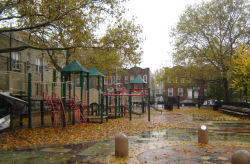Kennedy King Playground
Kennedy King Playground
This playground and the nearby school honor two 20th century American icons, the 35th President of the United States John Fitzgerald Kennedy (1917-1963) and civil rights leader Reverend Doctor Martin Luther King, Jr. (1929-1968). Constructed in 1957 as a school yard for P.S. 219, the playground is jointly operated by NYC Parks and Department of Education. In 1985, Parks Commission Henry Stern renamed the park Kennedy King Playground.
After serving as a naval officer during World War II, John F. Kennedy was elected to the United States House of Representatives from Massachusetts (1947-1953) and the United States Senate (1953 - 1960). He narrowly defeated Richard M. Nixon in the presidential election of 1960.
Elected the nation's first Catholic president, Kennedy presided over legislation creating the Peace Corps, advocated medicare and civil rights, approved the invasion of Cuba’s Bay of Pigs, orchestrated the removal of Soviet nuclear missiles from Cuban soil, and obtained signatures from both Great Britain and the USSR on a nuclear test-ban treaty. On November 22, 1963, President John F. Kennedy, while touring Dallas, Texas in a presidential motorcade, was assassinated by Lee Harvey Oswald (1939-1963).
Reverend Doctor Martin Luther King, Jr. was a pivotal figure in the civil rights movement of the 1950s and 1960s. Ordained a minister of the Baptist Church at age 19, he served as pastor of the Dexter Avenue Church in Montgomery, Alabama, and secured a reputation as an eloquent and committed proponent of social equality. He was elected President of the Montgomery Improvement Association and was responsible for the successful Montgomery bus boycott of 1955 - 1956. King resigned from the Dexter Avenue Church in 1959 in order to found and direct the Southern Christian Leadership Conference, an organization challenging racism with nonviolent civil disobedience.
In 1963, he organized a march on Washington to support proposed civil rights legislation. There he delivered his famous “I Have a Dream” speech. The following year King, at age 35, became the youngest man, second American, and third black man to win the Nobel Peace Prize. Martin Luther King, Jr., standing on a Tennessee motel balcony on April 4, 1968, was assassinated by James Earl Ray (1928-1998).
In 2004, the entire playground was renovated in a project that included new benches, spray fountain, flagpole, play equipment, paving stones, safety surfacing, and animal-themed artworks on the interior fences. Kennedy King Playground includes basketball hoops, handball courts, swing sets, and London plane trees add shade to the area.
Check out your park's Vital Signs
Clean & Safe
Green & Resilient
Empowered & Engaged Users
Share your feedback or learn more about how this park is part of a
Vital Park System

